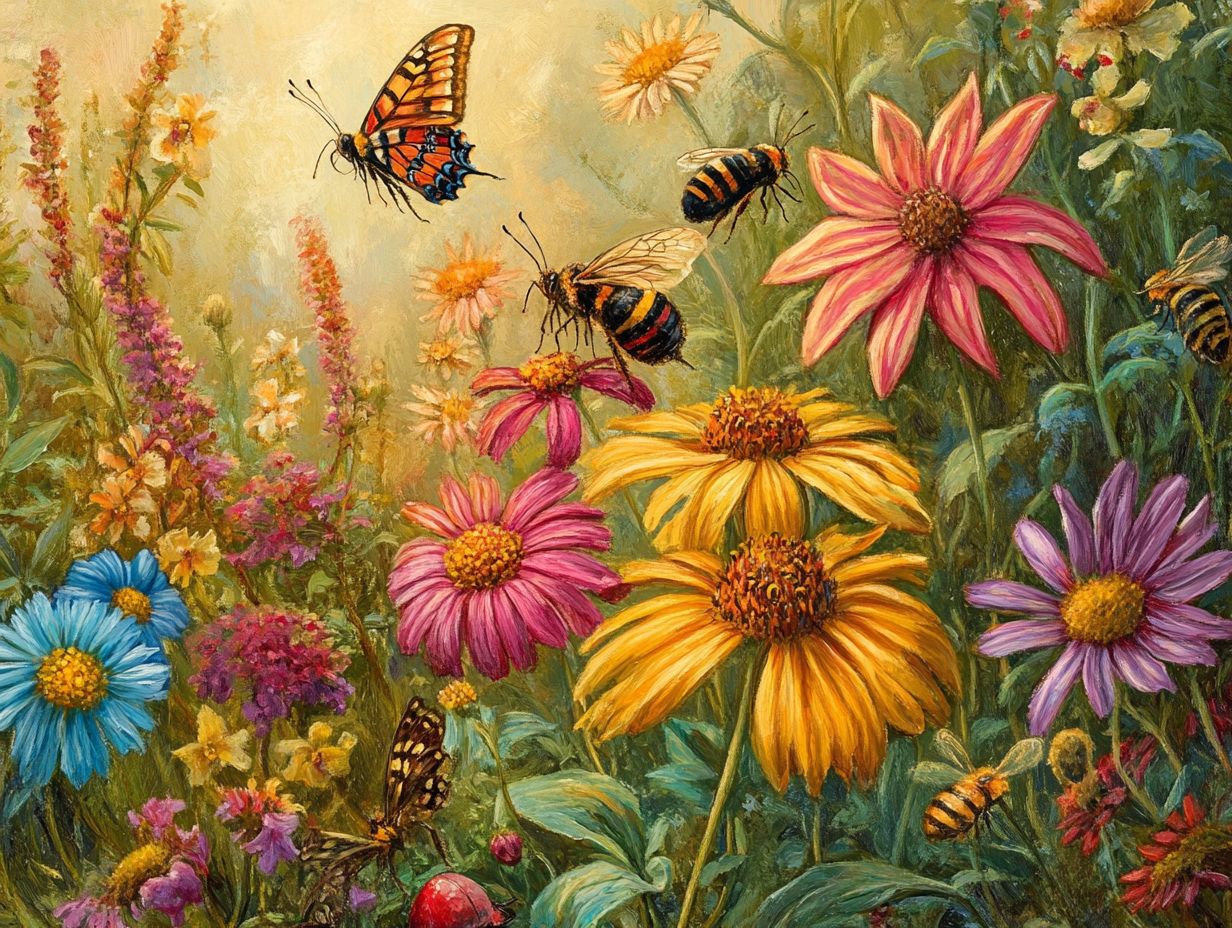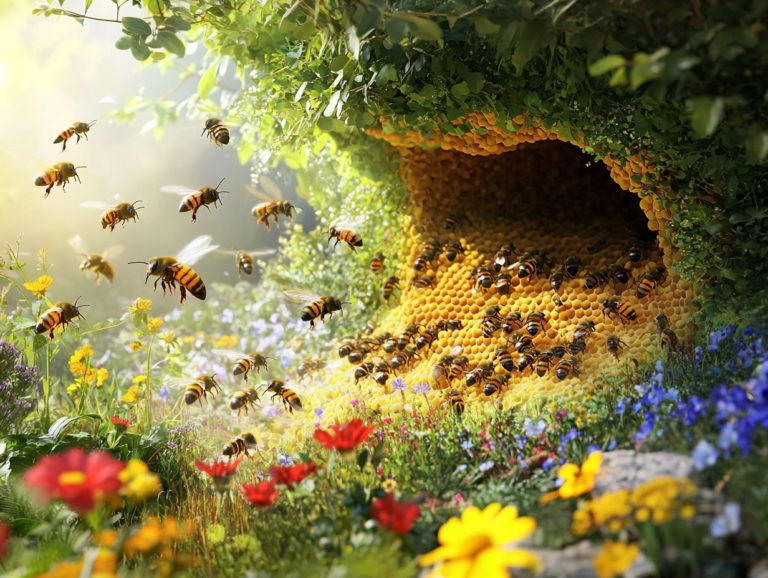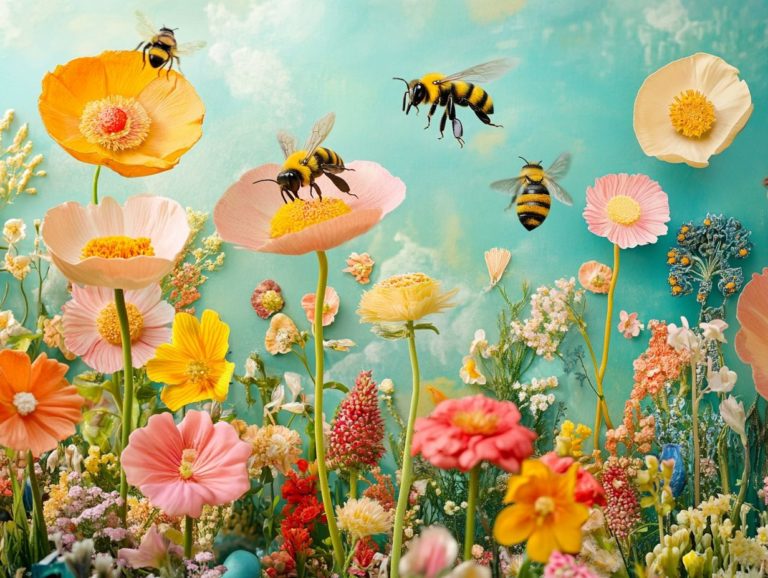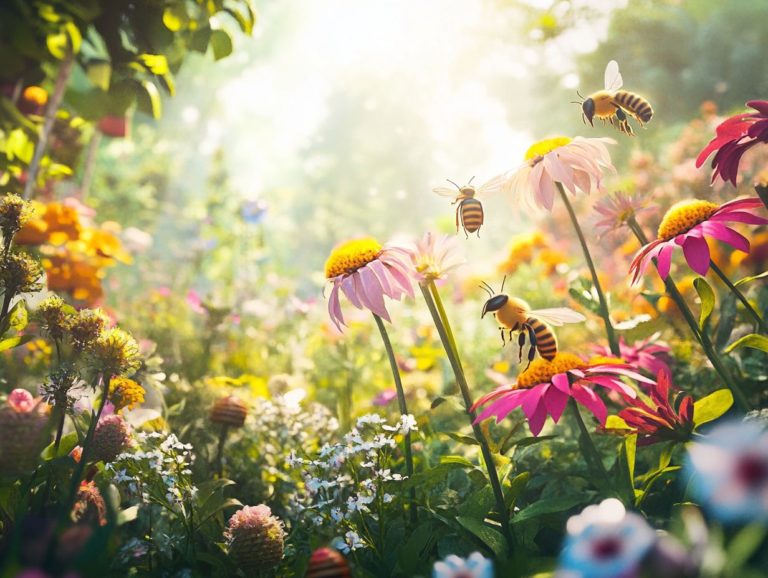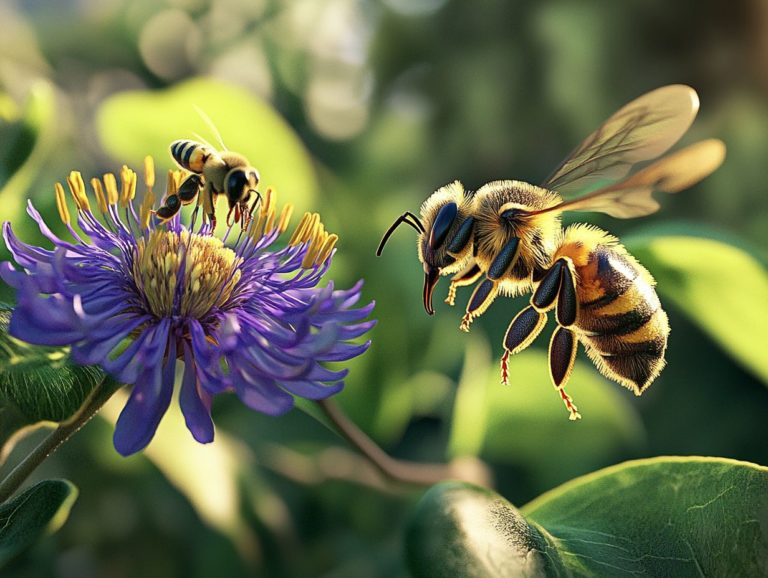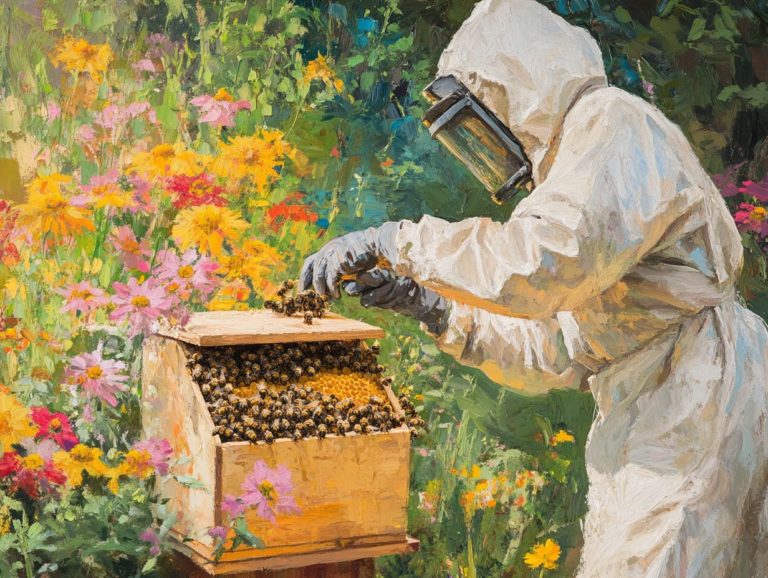How Bees Interact with Other Insects
Bees play an essential role in our ecosystem, primarily through their remarkable pollination efforts, which support plant life and food production. Their interactions with other insects, including other insect pollinators, are equally intriguing and complex. Whether it’s through competition for nectar resources or mutualistic relationships, bees significantly shape the dynamics of the insect community.
This article delves into how bees engage with other insects, examines the impacts of human activities on these relationships, including the threat of invasive species and the phenomenon of colony collapse disorder, and offers practical strategies for fostering a healthier environment for these buzzing allies. Join in as you uncover the intricate web of connections that defines the world of bees and their insect companions.
Contents
- Key Takeaways:
- The Role of Bees in the Ecosystem
- How Do Bees Interact with Other Insects?
- Examples of Bee Interactions with Other Insects
- The Impact of Human Activities on Bee Interactions
- How Can We Help Promote Positive Bee Interactions?
- Your Questions About Bees Answered!
- How do bees interact with other insects and other pollinator species?
- Do bees have social interactions with other insect species, such as bumble bees and solitary bees?
- What is the role of bees in the ecosystem and agricultural landscapes?
- How do bees interact with other insects and animal pollinators during foraging?
- Can bees interact with other insects in a negative way, affecting pollination efficiency?
- Why is it important to study how bees interact with other insects in relation to crop production?
Key Takeaways:
The Role of Bees in the Ecosystem
Bees play an essential role in maintaining the health and stability of natural ecosystems by facilitating the vital process of plant pollination, which is crucial for the reproduction of flowering plants and the overall health of flowering communities.
These remarkable pollinators honey bees, bumble bees, and solitary bees transfer pollen from one flower to another, promoting biodiversity and supporting the entire food supply chain, including critical food resources for various animal pollinators.
The economic value of bees extends well beyond agriculture; they influence crop production and yield while also contributing to environmental sustainability by ensuring the survival of diverse plant communities that depend on effective pollination services and sustainable agriculture.
Unfortunately, their decline driven by habitat loss and the use of pesticides poses a significant threat to food security, biodiversity, and the global economy.
What is Pollination and Why is it Important?
Pollination is the fascinating process where pollen makes its journey from the male anther of a flower to the female stigma, setting the stage for fertilization and seed production. This process is vital for the reproduction of flowering plants and is essential not only for natural ecosystems but also for agricultural success. Your food security and crop yields hinge on this delicate transfer, with insect pollinators especially bees playing a crucial role. They ensure that pollen is effectively transferred, enhancing crop quality and supporting the diverse plant communities that form the backbone of our food supply and ecological balance.
These hardworking insects, along with other pollinators like butterflies and moths, are pivotal to the health of agricultural systems. By enabling the reproduction of a variety of crops from luscious fruits and vegetables to nutritious nuts they enrich the nutritional diversity available to you while also boosting the livelihoods of farmers. The remarkable efficiency of bees, who can visit countless flowers in a single foraging trip, underscores their irreplaceable contribution to crop production and the economic benefit they provide, making them invaluable partners in the pursuit of sustainable food systems.
Thus, grasping the intricate mechanics of pollination and recognizing the vital roles these insects play is increasingly essential for safeguarding future food security and biodiversity, ensuring the continued economic value and ecological balance of our natural systems.
How Do Bees Interact with Other Insects?
Bees interact with various other insects, creating intricate relationships that impact pollination efficiency and ecosystem balance. These interactions fall into two main categories: competition for resources and mutualistic relationships.
In competition, species vie for nectar and pollen. In mutualism, bees and insects like butterflies benefit one another, enhancing crop yields and promoting cross-pollination.
Bees face threats from predatory insects like wasps. These predators can change how bees forage and affect their populations. Understanding these relationships is vital for protecting our bees!
Competition for resources among bees and other insect pollinators is a vital component of the ecosystem that shapes foraging behavior and pollination efficiency. Various bee species, such as honey bees and wild bees, often find themselves in a tussle for the limited nectar and pollen offered by flowering plants.
This struggle can significantly impact their populations and the overall effectiveness of the pollination services they provide to crops and flowering communities.
Other insect pollinators join this fray, each employing unique foraging strategies designed to optimize resource acquisition. As these species compete for the same floral bounty, their interactions can lead to shifts in colony health and dynamics.
Resource scarcity, for example, may trigger reduced reproduction rates or weaken colonies. This can ultimately affect biodiversity and the stability of our food supplies and food chains.
Understanding these relationships is crucial! They directly affect how well our crops yield and thrive.
1. Competition for Resources
Predation poses a significant threat to bee populations, particularly from predatory insects such as wasps, which can disrupt their foraging activities and lead to dwindling colony numbers. In response to this challenge, bees have evolved an array of defense mechanisms to safeguard themselves and their colonies, including aggressive behaviors and their infamous ability to sting.
Grasping these interactions is essential for maintaining ecological balance and conserving bee species that are vital for pollination, particularly for optimizing blooming periods of various crops.
The ongoing struggle between bees and their predators offers a captivating glimpse into nature, illustrating the interdependence of species within ecosystems. When bees encounter heightened predation, their populations can take a downturn, resulting in serious ramifications for the plants they pollinate and, by extension, for food security and crop production.
Pollination is crucial for a myriad of crops, and a decline in bee numbers can disrupt the delicate web of species interactions. This can lead to reductions in fruit and vegetable yields, ultimately impacting agricultural sectors and economic value.
Thus, the defensive adaptations of bees do more than just protect them; they play a fundamental role in sustaining biodiversity and supporting agriculture. This underscores the intricate connections that bind all living organisms together, including maintaining pollinator habitats and ecological balance.
3. Mutualistic Relationships
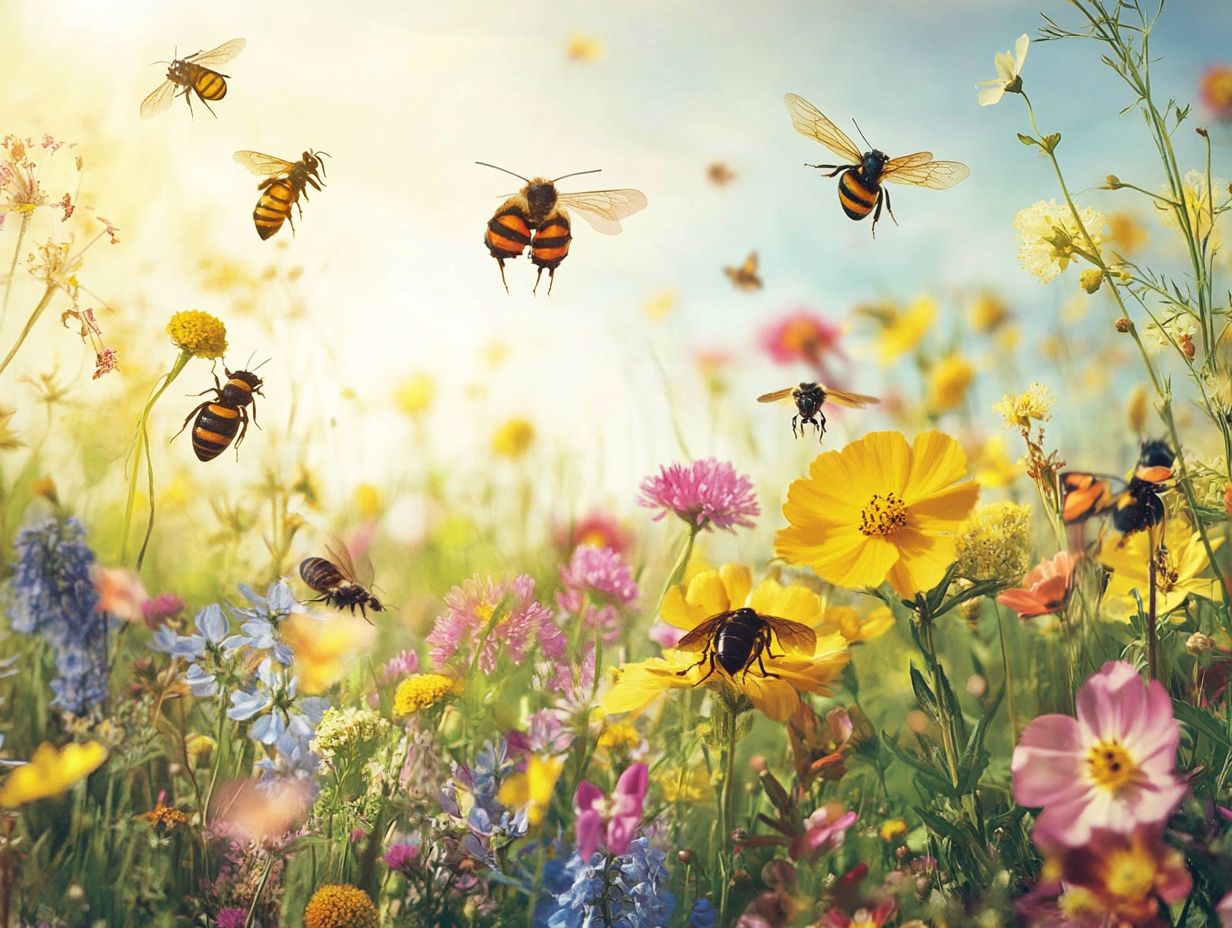
Mutualistic relationships between bees and other insects, such as butterflies, beautifully illustrate how ecosystems connect with each other. These interactions enable bees to access nectar from flowering plants while simultaneously aiding in cross-pollination, which is when pollen moves from one flower to another and helps improve plant reproduction. This significantly enhances crop quality and food production.
Such relationships are vital for maintaining ecological balance and fostering a resilient environment. They also optimize pollinator services.
Consider how, by collecting pollen and nectar, bees nourish themselves while facilitating the reproduction of a diverse array of flowering species. This incredible process boosts genetic diversity among plants, which is vital for thriving ecosystems and sustainable agriculture.
The interdependence between bees and flowering plants cultivates the growth of fruits and vegetables essential for human consumption. Without this natural harmony, many crucial food sources could diminish rapidly, affecting both ecosystems and our economy.
The synergy between these pollinators and plants highlights their key role in sustaining biodiversity and ensuring ecological stability.
Examples of Bee Interactions with Other Insects
Bees inhabit a world teeming with a variety of insects, creating a tapestry of ecological interactions that can either bolster or impede pollination services and crop production.
Consider the relationship between bees and butterflies; this largely mutualistic bond allows both to thrive as they visit the same flowering plants in search of nectar. This optimizes pollinator services and promotes environmental sustainability.
In contrast, encounters with ants can spark competition for resources, while interactions with beetles and wasps might lead to predation or resource overlap, impacting bee colonies and overall colony health.
By exploring these interactions, one gains a deeper appreciation for the crucial role bees play in sustaining biodiversity and supporting our food systems and agricultural sectors.
1. Bees and Butterflies
Bees and butterflies frequently find themselves drawn to the same flowering plants in search of nectar, forging a mutualistic relationship that benefits both parties. As they forage, bees diligently pollinate flowers, enhancing plant reproduction. Meanwhile, butterflies enrich pollinator diversity and contribute to the overall health of ecosystems, including agricultural production.
This interaction not only boosts the reproductive success of various plant species but also nurtures a vibrant habitat for countless organisms. As they visit many flowers, bees and butterflies help plants share genes, which is essential for the resilience of plant populations facing environmental changes.
Their roles within the ecosystem promote the growth of diverse plant communities, ultimately attracting a myriad of wildlife and ensuring the flourishing of ecosystems.
In essence, the collaboration between these pollinators is crucial for sustaining biodiversity; without it, the delicate balance of nature could be jeopardized.
2. Bees and Ants
Bees and ants often find themselves in subtle competition for similar resources, particularly nectar from flowering plants. This rivalry can create a dynamic that significantly influences their foraging behavior. While bees focus on pollination, ants are not shy about indulging in nectar, showcasing the complex ecological interactions that unfold in their shared habitats.
This competition for nectar doesn t just affect individual foraging strategies; it also shapes broader ecological outcomes. For example, bees, equipped with specialized adaptations for efficient nectar extraction and pollen transport, play an essential role in pollination. On the flip side, ants masters of opportunistic feeding can disrupt the foraging patterns of bees by monopolizing prime floral resources.
Understanding these dynamics helps us see how important these relationships are for a healthy ecosystem. Their presence often forces bees to rethink their foraging routes or timing, ultimately diminishing pollination efficiency.
Recognizing these dynamics is crucial, as it unveils how interspecies interactions can significantly influence ecosystem health and the productivity of flowering plants.
3. Bees and Beetles
The interactions between bees and beetles can vary from mutually beneficial to fiercely competitive, depending on the availability of floral resources, which include nectar and pollen essential for bee survival. Some beetles help pollinate flowers, while others elbow bees aside in the nectar game. This ultimately affects the overall efficiency of pollination in ecosystems.
These relationships significantly impact pollination success and the vitality of plant populations. When bees and beetles coexist, they can boost each other’s foraging efficiency. This collaboration can lead to increased fruit and seed production for flowering plants. In contrast, competition for scarce resources can lead to fewer bee visits, undermining their essential role in pollination.
Understanding these dynamics is crucial for ecological balance. Each group plays a unique role in the intricate web of life, affecting biodiversity and the stability of habitats across different ecosystems.
4. Bees and Wasps
Bees and wasps often inhabit similar environments, resulting in complex interactions. Unfortunately, this can put bees at risk of becoming prey to wasps, influencing their population dynamics. This predation pressure forces bees to develop various defense mechanisms to protect themselves and their colonies, highlighting the delicate balance within ecosystems.
As these two groups compete for resources, the predatory tendencies of wasps can pose a threat to bee populations, especially during peak foraging seasons. In response, bees have evolved various adaptive strategies, from aggressive defense behaviors to chemical deterrents, to fend off these formidable adversaries.
The survival of various bee species, vital for pollination and biodiversity, is closely linked to these complex interactions. Therefore, understanding these predatory relationships is essential for conserving bee populations and ensuring the overall health of our ecosystems.
The Impact of Human Activities on Bee Interactions
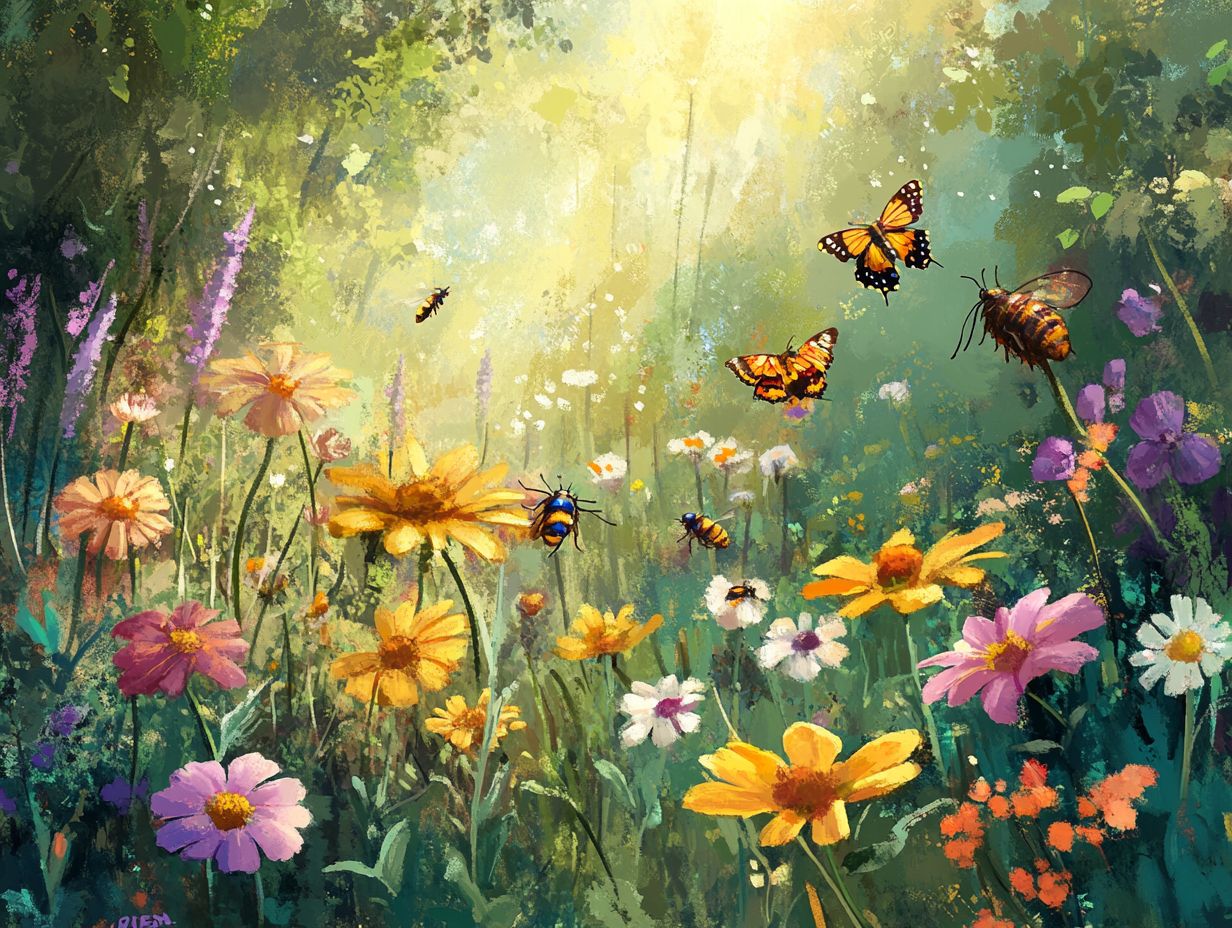
Your actions can significantly influence bee interactions and their important roles in nature, often in harmful ways. Habitat destruction, pesticide application, and the introduction of invasive species contribute to the decline of these crucial pollinators, jeopardizing biodiversity and the health of ecosystems dependent on pollination services.
When we destroy natural habitats, the availability of nectar resources and nesting sites for different bee species decreases. Pesticides pose a direct threat to bees and disrupt their foraging behaviors, further jeopardizing their survival.
1. Habitat Destruction and Fragmentation
Habitat destruction and fragmentation create significant challenges for bee populations by reducing the availability of pollinator habitats and disrupting foraging patterns. Urbanization and agricultural expansion encroach on natural landscapes, leading to the loss of diverse plant communities. This reduction diminishes the nectar resources critical for various bee species and contributes to a decline in biodiversity.
This decline not only threatens the survival of bees but also reverberates throughout the entire ecosystem. Bees play a crucial role in the reproductive processes of many plants. Without their essential services, agricultural yields and wild plant diversity face serious threats. The interconnectedness of ecosystems means that losing pollinators can trigger cascading effects, endangering other wildlife that relies on plants for food and shelter.
Therefore, prioritizing the preservation and restoration of pollinator habitats is vital for sustaining bee populations and the overall health of ecosystems. By ensuring these essential creatures thrive, you contribute to the well-being of our environment. What can you do to help protect our bees?
2. Use of Pesticides and Herbicides
The pervasive use of pesticides and herbicides in contemporary agriculture has been linked to alarming declines in bee populations, which in turn threatens pollinator services and disrupts the ecological balance.
These chemicals can directly harm bees, interfere with their foraging behaviors, and contribute to colony collapse disorder an issue that poses significant risks to food security and biodiversity.
This decline in bee health jeopardizes the natural processes of pollination. It carries far-reaching implications for crop yields and ecosystem resilience.
Given that bees are essential for pollinating many fruits, vegetables, and nuts, the consequences of their decline inevitably ripple through human diets and agricultural economies.
For farmers who depend on these crucial pollinators, productivity could dwindle, leading to higher food prices and a decreased availability of nutritious options. The ecological ramifications are equally troubling; failing bee populations can disrupt the delicate web of life that supports both wildlife and plant diversity.
This situation underscores the urgent need for sustainable pest management practices that safeguard these invaluable insects.
How Can We Help Promote Positive Bee Interactions?
Promoting positive interactions with bees is crucial for supporting their populations and ensuring effective pollination services within ecosystems. You can support local beekeepers and advocate for sustainable agricultural practices to make a significant contribution to the health of bee populations and their vital ecological roles.
One effective way to achieve this is by creating bee-friendly gardens that offer a diverse array of nectar and pollen resources, enhancing habitats for various bee species.
1. Planting Bee-Friendly Gardens
Creating a bee-friendly garden is not just a delightful endeavor; it s a powerful way to support bee populations by providing them with essential nectar resources and habitats. By choosing a diverse selection of flowering plants that bloom at various times throughout the year, you can ensure a continuous food supply for bees while simultaneously enhancing local biodiversity.
Incorporating native plants is particularly beneficial, as these species have developed together with local pollinators, offering bees the most nutritional value. When planning your garden s layout, think about clustering flowers together; this makes it easier for bees to forage efficiently.
It s also wise to introduce a mix of plant types, including perennials, annuals, and even shrubs, to cater to the varied preferences of different bee species. Don t overlook habitat considerations either. Leaving patches of bare ground for ground-nesting bees and providing water sources can significantly enhance your garden s appeal and utility for these essential insects.
2. Avoiding Harmful Chemicals
Avoiding harmful chemicals like pesticides and herbicides is essential for protecting bee populations and promoting environmental sustainability. By choosing organic gardening practices, you can create safer habitats for bees and enhance the overall health of ecosystems.
Embracing methods such as companion planting, crop rotation, and natural pest control reduces reliance on synthetic chemicals. This approach nurtures a diverse array of plant life that benefits pollinators, including honey bees and wild bees.
For example, planting flowers that bloom at various times throughout the seasons ensures a continuous food source for bees, helping them thrive and flourish. Utilizing organic mulches and compost not only enriches the soil but also minimizes weed growth without resorting to harmful herbicides.
These practices urgently protect bees and their habitats while contributing to a more resilient and productive agricultural landscape. Additionally, they support pollination services and enhance crop yield and crop quality.
Join the movement for sustainable gardening today!
3. Supporting Local Beekeepers
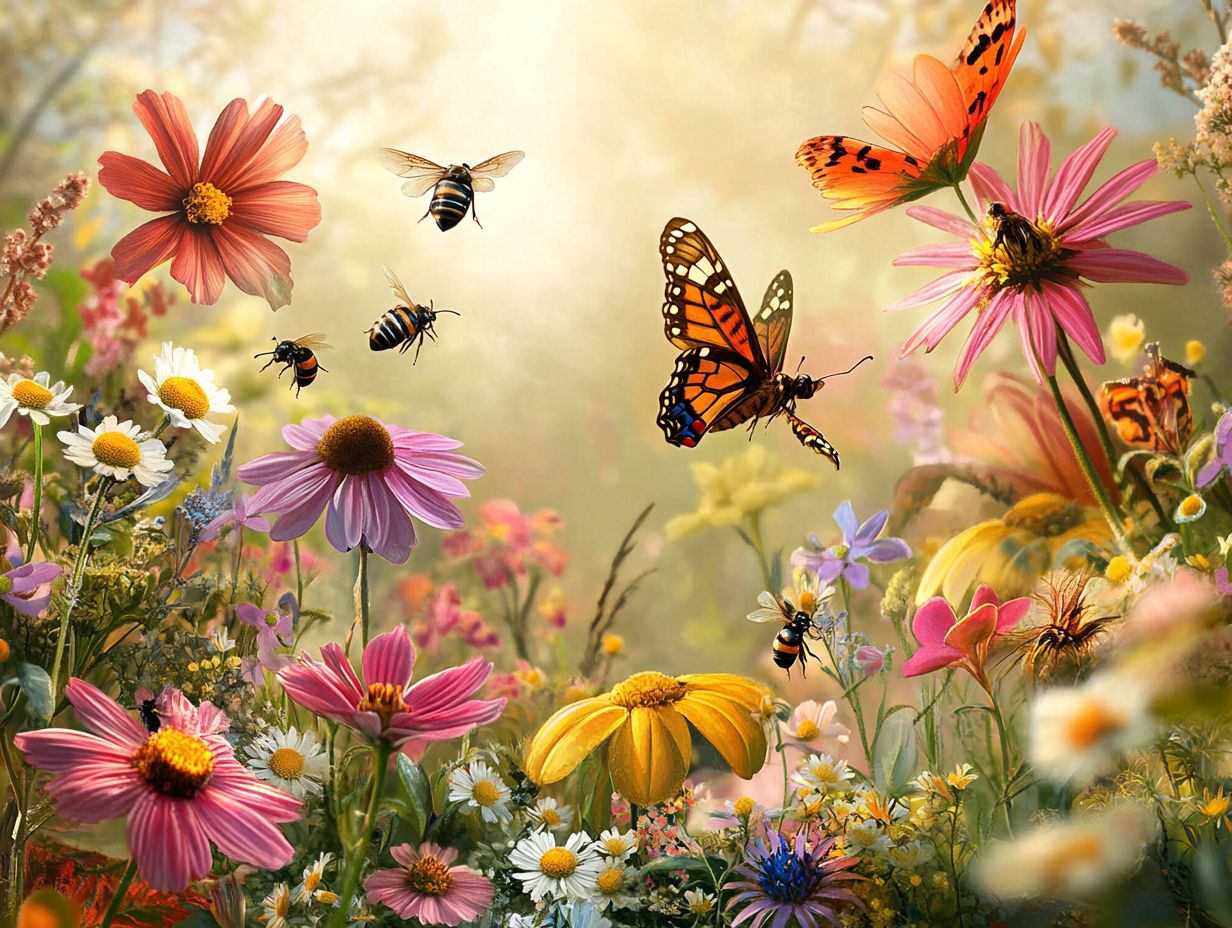
Supporting local beekeepers helps keep bee populations healthy. This ensures that pollinators can thrive in agricultural areas.
When you buy local honey or join community beekeeping projects, you help bee colonies and protect biodiversity. Your support boosts the local economy and strengthens your bond with nature.
Participating in beekeeping workshops or educational programs can elevate your awareness of the vital roles these pollinators play in our ecosystems. You can also advocate for local policies that protect bee habitats and promote sustainable farming practices.
Taking these steps is vital! It helps fight pollinator decline and stops the alarming collapse of bee colonies.
By reducing the use of harmful pesticides and incorporating native flowering plants in your garden, you can create a welcoming environment for bees. This practice enhances environmental sustainability by supporting diverse flowering communities and improving pollination efficiency.
Every action you take in support of local beekeepers contributes to safeguarding these essential pollinators. Supporting bees directly influences agricultural production and ensures food security by facilitating plant pollination and enabling cross-pollination, which are vital for crop production and food supply.
Your Questions About Bees Answered!
How do bees interact with other insects and other pollinator species?
Bees interact with other insects through a variety of behaviors such as foraging and pollination. These interactions can influence the health of pollinator habitats and the availability of nectar resources.
Yes, bees have social interactions with other insects such as ants, wasps, and butterflies. They may compete for food resources or form mutually beneficial relationships.
What is the role of bees in the ecosystem and agricultural landscapes?
Bees play a crucial role in pollination, essential for the reproduction of many plant species. They also serve as a food source for other insects and animals.
How do bees interact with other insects and animal pollinators during foraging?
During foraging, bees may compete for flower resources or engage in mutualistic relationships. These behaviors are critical for pollination services and crop optimization.
Can bees interact with other insects in a negative way, affecting pollination efficiency?
Yes, bees can negatively interact with other insects through competition for resources or aggressive behaviors. These interactions can impact the availability of nectar and pollen.
Why is it important to study how bees interact with other insects in relation to crop production?
Studying how bees interact with other insects provides insights into the complex relationships within ecosystems. It helps us understand the vital role bees play in maintaining the balance of our natural world.
This knowledge is vital for improving agricultural practices and promoting sustainable agriculture.

